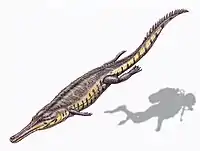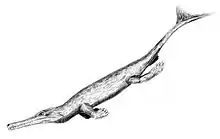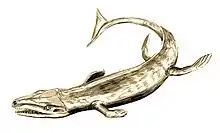Metriorhynchinae
Metriorhynchinae is a subfamily of metriorhynchid crocodyliforms from the late Middle Jurassic to the Early Cretaceous (Callovian - Valanginian) of Europe, North America and South America.[1][2] Named by Fitzinger, in 1843, it contains the metriorhynchids Metriorhynchus, Gracilineustes, Cricosaurus, Maledictosuchus and Rhacheosaurus. The last three taxa form a tribe within Metriorhynchinae, the Rhacheosaurini. Metriorhynchinae is one of two subfamilies of Metriorhynchidae, the other being Geosaurinae.[3]
| Metriorhynchines | |
|---|---|
 | |
| Thalattosuchus superciliosus skeleton, Senckenberg Museum of Frankfurt | |
| Scientific classification | |
| Kingdom: | Animalia |
| Phylum: | Chordata |
| Class: | Reptilia |
| Suborder: | †Thalattosuchia |
| Family: | †Metriorhynchidae |
| Subfamily: | †Metriorhynchinae Fitzinger, 1843 |
| Genera | |
| |
Phylogeny
Metriorhynchinae is a stem-based taxon defined in 2009 as the most inclusive clade consisting of Metriorhynchus geoffroyii, but not Geosaurus giganteus.[4] Rhacheosaurini is a stem-based taxon and it was named and defined by Mark T. Young, Mark A. Bell and Stephen L. Brusatte in 2011 as the most inclusive clade including Rhacheosaurus gracilis, but not Metriorhynchus geoffroyii and Gracilineustes leedsi.[3] The cladogram below follows the topology from the analyses by Young, et al. 2020.[5][6]
| Metriorhynchinae |
| ||||||||||||||||||||||||||||||||||||||||||||||||||||||||||||||||||||||||||||||||||||||||||||||||||||||||||||
References
- Andrea Cau; Federico Fanti (2011). "The oldest known metriorhynchid crocodylian from the Middle Jurassic of North-eastern Italy: Neptunidraco ammoniticus gen. et sp. nov". Gondwana Research. 19 (2): 550–565. doi:10.1016/j.gr.2010.07.007.CS1 maint: uses authors parameter (link)
- Mark T. Young, Stephen L. Brusatte, Marcello Ruta and Marco Brandalise de Andrade (2010). "The evolution of Metriorhynchoidea (Mesoeucrocodylia, Thalattosuchia): an integrated approach using geometrics morphometrics, analysis of disparity and biomechanics". Zoological Journal of the Linnean Society. 158 (4): 801–859. doi:10.1111/j.1096-3642.2009.00571.x.CS1 maint: uses authors parameter (link)
- Mark T. Young, Mark A. Bell and Stephen L. Brusatte (2011). "Craniofacial form and function in Metriorhynchidae (Crocodylomorpha: Thalattosuchia): modelling phenotypic evolution with maximum-likelihood methods". Biology Letters. 7 (6): 913–916. doi:10.1098/rsbl.2011.0357. PMC 3210659. PMID 21543396.CS1 maint: uses authors parameter (link)
- Mark T. Young and Marco Brandalise de Andrade (2009). "What is Geosaurus? Redescription of Geosaurus giganteus (Thalattosuchia: Metriorhynchidae) from the Upper Jurassic of Bayern, Germany". Zoological Journal of the Linnean Society. 157 (3): 551–585. doi:10.1111/j.1096-3642.2009.00536.x.CS1 maint: uses authors parameter (link)
- Young MT, Sachs S, Abel P, Foffa D, Herrera Y, Kitson JJN (2020). "Convergent evolution and possible constraint in the posterodorsal retraction of the external nares in pelagic crocodylomorphs". Zoological Journal of the Linnean Society. 189 (2): 494–520. doi:10.1093/zoolinnean/zlaa021.CS1 maint: uses authors parameter (link)
- Young, M.T., Brignon, A., Sachs, S., Hornung J.J., Foffa, D., Kitson, J.J.N., Johnson, M.M., and Steel, L. 2020. Cutting the Gordian knot: a historical and taxonomic revision of the Jurassic crocodylomorph Metriorhynchus. Zoological Journal of the Linnean Society, zlaa092. https://doi.org/10.1093/zoolinnean/zlaa092.


